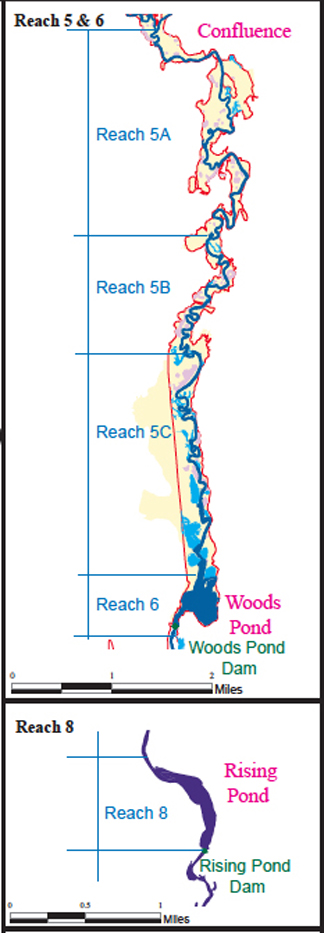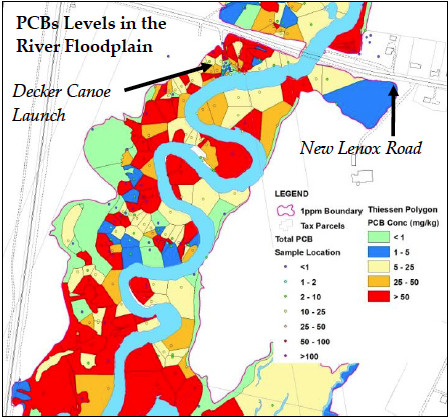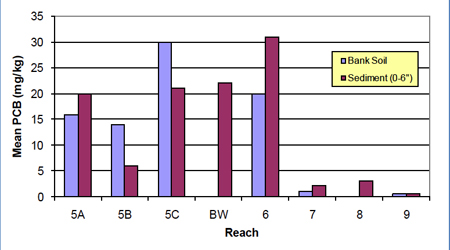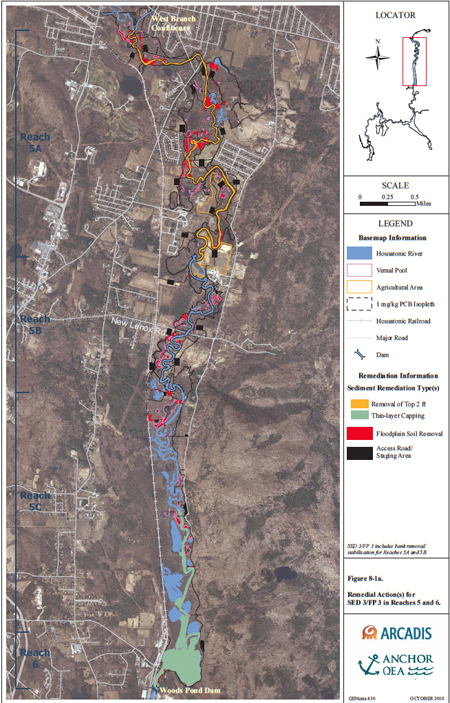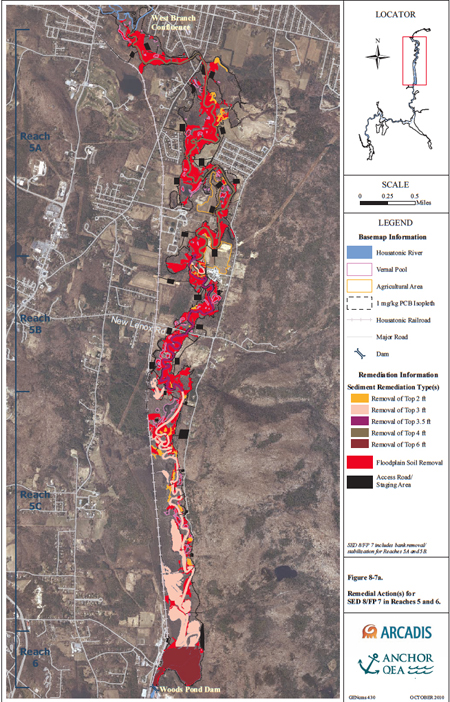By Mickey Friedman
August 5, 2011
EPA Region One officials responsible for the GE/Housatonic River site spent two days on July 27-28, 2011 presenting a cleanup plan for “The Rest of the River” to the agency’s National Remedy Review Board (NRRB).
Made up of senior technical and policy experts from EPA regions across the country, NRRB serves as a peer review board mandated to ensure that any Housatonic River cleanup decision is consistent with other EPA remedies, cost-effective, and contributes to protecting human health and the environment.
While local EPA officials, GE, and the citizens of Berkshire County await a decision – said to take approximately 60 days while first the NRRB makes comments, and then the Region One officials refine their proposal – it’s instructive to take a look at some of what Berkshire stakeholders told the NRRB. The EPA posted these comments on August 1, 2011.
Here’s a diagram prepared by GE showing how the Rest of the River has been divided into Reaches. The proposals discussed below often refer to different ways to deal with the PCB problems in the different Reaches:
Kenneth Finkelstein of the National Oceanic and Atmospheric Administration (NOAA) offered comments in an attempt “to find a final remedy compromise between EPA and GE.” While acknowledging that EPA’s studies of environmental risk assessment “is better supported by past work in this field” than GE’s, Finkelstein suggests the EPA accept higher levels of PCB concentration in the river sediment, and a cleanup that will ultimately allow a higher level of PCBs in fish than it might prefer.
In the spirit of compromise, Finkelstein endorses GE’s proposed cleanup scenario known as SED 3. SED 3 is one of many cleanup plans GE presented in its 2010 Corrective Measures Study (CMS.) SED 3 calls for a 10-year cleanup which includes removing 134,000 cubic yards of river sediment “down to a depth of two feet followed by placement of a 2-foot cap over the removal areas” over 42 acres in Reach 5A.
The riverbanks in Reach 5A and 5B over a course of 14 miles will be stabilized and during that process 35,000 cubic yards of riverbank soil will be removed. The downstream portions of Reach 5C and Reach 6, and Woods Pond, would be capped with a 6-inch layer of sand, while the rest of the river, including Rising Pond would be covered by “monitored natural recovery,” GE’s version of letting nature taking its course. GE estimates that the cleanup cost of SED 3 would be approximately $177 million.
By comparison, GE’s option SED 9 calls for removing sediments and bank soils throughout Reach 5A, B, C, the backwaters, the removal of PCB sediments down to 3.5 feet in some areas of Woods Pond, as well as removing PCB-contaminated sediments in Rising Pond up to 1.5 feet. GE estimates that this alternative would cost $394 million.
Finkelstein’s plan would involve leaving significant levels of PCBs in both river sediments beneath a thin-layer cap, and in the riverbanks. GE would not have to dredge Woods Pond, nor clean up Rising Pond in Housatonic.
These two charts created for the EPA shows how the PCBs are distributed in the river sediment and bank soils along the “Rest of the River.”
The Housatonic Valley Association (HVA) takes a different approach than NOAA. They begin by setting out a series of principles they feel should inform any decision process for the River:
(1) That remediation should restore the river to a “fishable” and “swimable” water body. (2) Cleanup should be to the best ability of technology regardless of time, money and temporary aesthetic damage. A careful and thorough cleanup may require sacrificing short-term aesthetics and use of the area in order to protect this and future generations (human and wildlife) by providing them with a clean, safe and naturally beautiful river and riparian landscape. (3) Post-remediation PCB concentrations should meet the lower range of IMPG concentrations. (4) The river should be able to flow and move as rivers naturally do.
Therefore, enough contaminated bank and flood plain material must be removed and replaced to allow some meandering, rather than leaving contaminated material behind armored banks that prevent natural movement. (5) The risk of recontamination should be minimized.” (GE-Housatonic River Combined Stakeholder Comments to NRRB, Revised CMS, 37)
These principles lead HVA to the determination that GE’s cleanup options (and the NOAA proposal) that include Monitored Natural Recovery and Thin-Layer Capping won’t result in a fishable, swimmable river. HVA offers a menu of options from GE’s list, including in Reaches 5 through 8, sediment options SED 5 and 6, and flood plain bank option FP7.
Here are two color coded maps showing where and how much remediation will take place in the NOAA proposal, GE’s SED 3 option, followed by the more rigorous cleanup option of SED 8/FP7 in Reaches 5 and 6.
In SED 3, the blue represents the Housatonic River. Areas colored yellow show where up to two feet of sediment will be removed. Green shows areas where a two-foot thin layered cap of sand will be employed. Red shows areas where floodplain soil will be removed. And the black areas are the areas where equipment staging will take place.
For SED 7 we have additional coloring to represent removal levels beyond the two-foot level of SED 3. Flesh color represents removal up to 3 feet; purple up to 3.5 feet; army green up to 4 feet; and rust up to 6 feet.
You can see that far larger areas of the contaminated riverbank will be cleaned under the SED 8 plan below. Contaminated river sediments, up to six feet in some sections, will be cleaned up and Woods Pond will have contaminated sediments removed:
Attorney C. Jeffrey Cook, whose home abuts the river in Pittsfield, took the opportunity to write to the NRRB to scold the EPA team responsible for the Housatonic River site:
I am writing to you now because I have become convinced that, in their “greater wisdom,” the EPA personnel who are driving the Rest of River Project for the Housatonic River (the “Rest of River Group”) are determined to pursue a course of action which will result in the people of Berkshire County coming to know your agency as a destroyer of the environment rather than the protector.
Cook believes the EPA team has fallen under the influence of the Housatonic River Initiative (HRI), a group of river advocates who have received state and federal money to provide technical assistance to the community. He writes:
We do not accept the assurances that the EPA and others who may be involved really understand the logistical nightmare it will be to (1) create the access roads and staging areas needed, (2) get the work done in a reasonable time frame and with as few negative impacts in terms of noise, etc., as possible, and (3) restore the river, river banks and other areas after the dredging and replication are done. We have heard the Regional Administrator for this region of EPA says that he will get the job done even if takes 50 years. Curt Spalding appears to have bought into the dogma of HRI: EPA and HRI have to really show GE that it cannot get away with not cleaning up the damage it did (much with government permits at the time) if that process will destroy the river in order to save it. GE, which can be its own worst enemy, is not the issue. Destruction of the river is. (GE-Housatonic River Combined Stakeholder Comments to NRRB, Revised CMS, 236-7)
Peter DuFur, the President of Environmental Stewardship Concepts, LLC and the technical advisor to the Housatonic River Initiative stressed that each phase of the cleanup “should include pilot projects to test new technologies.”
To create a tailored and comprehensive plan, small-scale pilot projects should be conducted to assess the effectiveness and appropriateness of emerging remediation technologies. HRI and community members support a cleanup option that will effectively remove contaminated sediment altogether where feasible. Therefore, technologies that remove contaminated sediment/ soil through the least intrusive and most cost-effective methods will, in most areas of the site, be the favored remedial methods. Additional methods that treat contaminated sediment/ soil without requiring removal should be considered as well, to be used in areas where sediment/ soil removal is not a feasible or appropriate method. (GE-Housatonic River Combined Stakeholder Comments to NRRB, Revised CMS, 24-5)
The Commonwealth of Massachusetts renewed its complaint that the EPA Region One team hadn’t adequately consulted with the state:
As we write these comments, while we now have a general understanding from Region 1 of their concerns about certain aspects of the Commonwealth’s conceptual remedy proposal, we have not had detailed discussions with Region 1 regarding the scope and ramifications of the sediment, floodplain and disposal components of Region 1’s proposed remedy. We continue to be disappointed that a remedy is being presented to you without the Commonwealth being fully briefed, and believe that this detracts from your ability to evaluate the proposed remedy, and whether it has the support of key stakeholders. For these reasons, the Commonwealth requests that the Board’s comments back to Region 1 include the directive that Region 1 directly engage with the Commonwealth on the specifics of Region 1’s proposed remedy, and then report back to the Board on how Region 1 has considered and addressed the Commonwealth’s interests and concerns, with reference to underlying principles and balancing approach of our alternative remedy proposal.
The Commonwealth then repeated its concern that the proposed remedy not include “intrusive work on the riverbanks and elsewhere that results in actual damage to unique ecological resources that exceeds the benefits of lower PCB levels to wildlife.” (GE-Housatonic River Combined Stakeholder Comments to NRRB, Revised CMS, 140)
It’s interesting to examine the contrasting beliefs of HRI and the Commonwealth of Massachusetts. HRI stresses the threats PCBs pose to humans and wildlife, and concludes:
Therefore it is of greatest importance to protect these sensitive areas through a comprehensive cleanup effort, which effectively removes the threat of PCB exposure on endemic species. A thorough remediation plan must recognize the dire human and ecological health problems associated with lingering PCB contamination. (GE-Housatonic River Combined Stakeholder Comments to NRRB, Revised CMS, 23)
The Commonwealth believes the process of reducing the PCBs levels low enough so they won’t pose a threat to wildlife and humans is too costly in terms of destruction to the environment. And, despite the evidence of the effective cleanup GE and EPA performed in the first two miles of the river, like C. Jeffrey Cook, the Commonwealth doesn’t trust that EPA to minimize destruction during a cleanup or do a truly effective job of river restoration.
So the Commonwealth suggests dredging Woods Pond but is against removing PCBs from the rest of the river and the riverbanks:
Perform no bank or river excavation and stabilization as such work, by its nature permanently changes the character and ecosystem of the river. Such work is not necessary to meet any of the direct-contact human health goals identified by the EPA and will inevitably cause severe and long-lasting destruction of the Housatonic River ecosystem and state-listed rare species, which far outweighs any environmental benefits from PCB removal. (GE-Housatonic River Combined Stakeholder Comments to NRRB, Revised CMS, 146)
To those who have followed the continuing controversies surrounding the PCB contamination of the Housatonic River, it is no surprise that opinions are so varied when it comes to trying to find a solution.
By the time the EPA National Remedy Review Board works its way through these public comments, they will all have a better idea of what life has been like for their EPA Region One counterparts.


